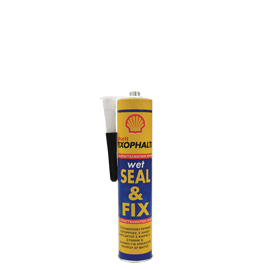TIXOPHALTE is a plasto-elastic, neutral hardening mastic, based on a (thixotropic) high-quality modified bitumen/rubber composition and contains additives, filler and a non flammable solvent. Adheres and seals undermany different conditions. Sticks to wet substrate (even under water). Sticks to most plastics, e.g. polyethylene.
- Roof-Terraces: Adhesives for all types of roofing felts; including SBS and APP bitumen modified membranes.Waterproof finishing of overlaps, connections and joints of roof edges, chimneys, light domes and bushings for exhaust pipes. Fixing rain water drain systems onto the roof.
- Constructions: Suitable for sealing vertical and horizontal joints, on various materials like concrete, brick or steel. Also suitable for the adhesion of common building materials.
- hydraulic applications: For waterproofing cracks and joints in waterways, canels dams, bridges and reservoirs taking advantage of its unique wet-weather and underwater properties.
Substrate
A clean, dry and dust free substrate is recommended. For special applications and/or on wet substrates an adhesion test is advised.
Application
TIXOPHALTE can be applied with a hand gun or compressed airgun. Using the cartridge, the aluminium seal in the front screw spout has to be cut slantwise so that it has the size of the desired band of TIXOPHALTE. A clean spout is important for a uniform dose and a smooth finish. In order to obtain adequate adhesion on a wet substrate, it is important that the distance between substrate and spout is as small as possible and not more than 3 mm, so that the initial adhesion is obtained by displacing the water. When compressed-air guns are used (for the sausage-packing) the piston and the cylinder have to be greased properly. TIXOPHALTE must be applied in strips or spot wise, so that the solvent is able to evaporate easily. Ensure that there is adequate ventilation during use. The open time and hardening rate are influenced by factors such as temperature, type of substrate, absorbency behavior of the materials and the applied layer thickness of TIXOPHALTE. Immediately after applying TIXOPHALTE, the adhesion is sufficient to resist a low load. Maximum strength is obtained after curing by evaporation of the solvent. The final adhesive strength is strongly dependant on the type and nature of the bond. TIXOPHALTE can be removed with tools, such as a palette knife. Any residue can be cleaned by dissolving in a solvent (e.g. special solvent SM-25).




